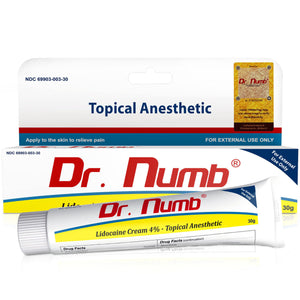An eyebrow piercing typically causes less pain than other piercings. You may feel a pinch or some pressure, but it shouldn't be unbearable. Your eyebrow piercing might cause you more discomfort and swelling than other piercings.
One of the most pressing questions that many potential eyebrow-piercing enthusiasts may have is how painful the process is. A pain scale exists to help provide an accurate picture of what one can expect.
In this post, we'll dive into what an eyebrow piercing entails, the factors that affect pain levels, and some tips for managing discomfort during and after the procedure.
How Painful is an Eyebrow Piercing: Pain Scale & Experience

One of the most common concerns people have before getting an eyebrow piercing is the level of pain they can expect. The pain scale used for eyebrow piercings ranges from 2 to 5 out of 10, depending on your pain tolerance and the method of piercing.
Most people score their pain in the 2-5 out of 10 range. The good news is that the piercing is only a brief moment of despair, likely lasting only a few seconds.
Patient Experience:
While it can be difficult to predict precisely how much pain a person may experience, there is always a certain level of discomfort involved with any kind of body modification. Many people find the pain of an eyebrow piercing to be very manageable. Some patient’s experiences:
- "I anticipated a lot of pain, but it hurt less than I thought. The initial piercing was a quick pain shot but faded away quickly."
- "It wasn't as bad as I was expecting, but it does sting a bit for a couple of minutes after the piercing is done."
- "The piercing hurt a bit more than I anticipated, but the pain didn't last long, and the result was worth it."
Eyebrow Piercing Pain: 5 Factors Affecting
While some people may find the process relatively painless, others may experience discomfort or intense pain. We will explore the various factors affecting the pain levels associated with an eyebrow piercing.
Anatomy of the Eyebrow
The anatomy of the eyebrow plays a crucial role in determining the level of pain associated with piercing. The eyebrow comprises numerous small muscles, nerves, and blood vessels, varying in density and sensitivity from person to person. The closer these structures are to the skin's surface, the more likely they will be affected by the piercing process.
- The thickness of the skin in the eyebrow area can affect pain intensity during piercing.
- Individuals with more prominent brow bones may feel more intense pain due to the denser tissue beneath.
- The nerve endings in the eyebrow region are incredibly dense, contributing to the pain factor.
Type of Piercing
The tool used for eyebrow piercing can also significantly affect pain levels. Two primary methods of piercing the eyebrow are a needle and a gun.
- A needle piercing tends to be less painful than a gun piercing as the needle moves through the skin more easily.
- A gun piercing can cause additional trauma to the skin, leading to more discomfort.

Experience and Skill of the Piercer
The experience and skill level of the piercer also play a crucial role in determining pain levels during eyebrow piercing. A skilled piercer can minimize discomfort and pain through their precision and expertise.
- Look for a piercer with many years of experience or a certification from a professional organization.
- A seasoned piercer with the right tools can perform the procedure with minimal discomfort.
Anxiety and Pain Tolerance Levels
Personal factors like pain tolerance levels and anxiety can influence the intensity of pain felt during an eyebrow piercing. While some individuals may tolerate pain better than others, anxiety levels can significantly affect whether the individual experiences more incredible pain.
- Anxiety and fear of the piercing process may increase the sensation of pain.
- Individuals with lower pain tolerance may require additional anesthetic or pain relief methods, such as ice or numbing cream.
Aftercare Process
The aftercare process can also affect pain levels associated with eyebrow piercing. Proper cleaning and care can reduce the risk of infection, which can cause discomfort and pain.
- Follow the aftercare instructions provided by your piercer carefully.
- Apply a saline solution to the piercing regularly to keep it clean.
- Avoid touching or twisting the piercing, especially in the first few days.
A Painful Eyebrow Piercing: 3 Tips for Reducing
it can still cause discomfort and pain, especially if proper preparation and aftercare are not followed. We will discuss some tips for reducing pain during and after an eyebrow piercing procedure.
Preparation Before Piercing

Before getting an eyebrow piercing, preparing your body and mind for the procedure is essential. The following tips can help you reduce pain and discomfort during the piercing:
- Get enough rest and stay hydrated: Get a good night's sleep before the procedure and drink plenty of water to stay hydrated.
- Eat a healthy meal: Eating a nutritious meal before the procedure can help you feel more energized and reduce the risk of fainting or dizziness.
- Avoid alcohol and drugs: Avoid consuming alcohol and drugs before the procedure, as they can make you more sensitive to pain and reduce your ability to respond to the piercing.
- Arrive on time and be relaxed: Arrive for your appointment so you do not feel rushed or stressed. Being simple can help you cope with pain and anxiety during the procedure.
Anxiety and Pain Management Techniques
While getting an eyebrow piercing, you may experience some pain and discomfort. However, there are several techniques you can use to manage anxiety and pain during the procedure. The following tips may be helpful:
- Listen to music or meditation: During the procedure, you can listen to music or meditation to help you relax and reduce pain.
- Deep breathing: Deep breathing can help you manage anxiety and reduce pain. Take deep breaths and exhale slowly during the piercing.
- Communicate with your piercer: Talk to your piercer about your concerns and feelings during the procedure. They can help you feel more comfortable and provide additional support.

Pain Reduction Post-Piercing Tips
After the eyebrow piercing, properly caring for the pierced area is essential to avoid infections and reduce discomfort. You may find the following tips helpful:
- Cleanse the area: Cleanse the pierced area with saline solution or sterile saline water twice daily.
- Avoid touching the piercing: Avoid touching the pierced area with dirty hands or fingers. This can introduce bacteria into the piercing and cause infections.
- Avoid swimming and hot tubs: Avoid swimming and using hot tubs for at least two weeks after the piercing. These activities pose the risk of infecting the piercing with bacteria.
- Use ice packs: If you experience swelling or discomfort after the piercing, you can use ice packs to reduce pain and inflammation.
Conclusion
The pain level of an eyebrow piercing dramatically depends on various factors: the individual's anatomy, the type of shooting method used, the experience level of the piercer, the individual's pain tolerance, and the aftercare process.
While some may find the piercing process uncomfortable or mildly painful, these factors can significantly affect the overall experience. Preparing beforehand and properly managing anxiety during the procedure is essential to reduce the discomfort of an eyebrow piercing.
It's also vital to follow post-piercing care instructions to avoid further discomfort. Everyone's pain tolerance and experiences are different, so it's crucial to research and understand the risks before getting an eyebrow piercing. This blog post has helped you in your decision-making process.

![Five factors that affect the pain of eyebrow piercings [for precautions]](http://drnumb.com/cdn/shop/articles/How_Painful_is_an_Eyebrow_Piercing__5_Factors_3_Tips.jpg?v=1705668955&width=1100)





![The Recovery Time and Stages of Nipple Piercings [Best Practices]](http://drnumb.com/cdn/shop/articles/How_Long_Do_Nipple_Piercings_Take_To_Heal__3_Stages_Explained.jpg?v=1714373243)

